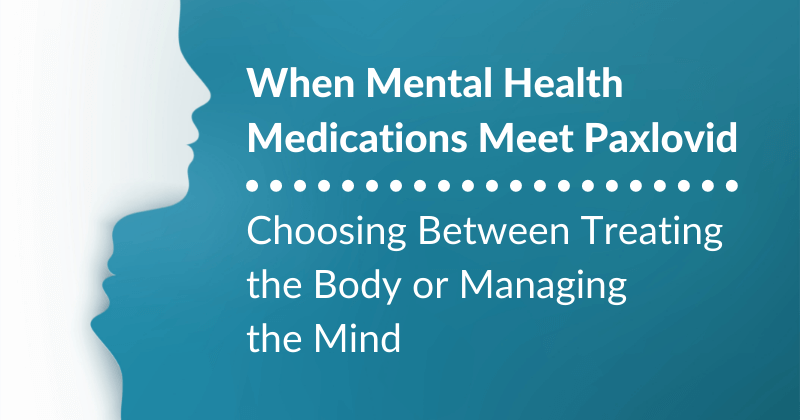When Mental Health Medications Meet Paxlovid: Choosing Between Treating the Body or Managing the Mind

Mental health has long been a taboo topic in my life. I am the daughter of Baby Boomers, one of whom belongs to the Blackfoot Nation, and discretion has always been valued: that is, no one airs out the dirty laundry, with mental health being the most unmentionable of all. After a childhood of severe abuse and abject neglect, I was diagnosed with Complex Post-Traumatic Stress Disorder (C-PTSD), along with Survivor Guilt. Over time, however, I uncovered a regimen that worked for me, which included talk therapy with a licensed clinician, medication, and a robust support system.
By mid-June, when I fell ill with COVID, I had been diligently proactive in managing my mental health for several months. Wanting to minimize time off from work, I decided to see what could expedite my physical recovery. I secured a telehealth appointment with a provider contracted through my local clinic. The physician confirmed that I met eligibility guidelines to be prescribed Paxlovid, an oral antiviral that combines two separate medications: nirmatrelvir, a SARS-CoV-2 protein inhibitor, and ritonavir, which is most famously known for use in the treatment of HIV/AIDS. The medication disrupts the pace of COVID’s infection by preventing the replication of coronavirus cells. Currently, Paxlovid is regarded as the most effective strategy for keeping COVID-infected patients out of the hospital; clinical trials determined that Paxlovid could reduce the likelihood of hospitalization and death by 89%.
Despite my eligibility, his contractual status meant that he could not write the prescription for me. He directed me to locate a test-and-treat site in my area. The next day, the new provider introduced more complications: if I remained medication compliant, no provider would write me such a prescription. Paxlovid is contraindicated with 22 medications, including those I use to manage my C-PTSD. She also advised me that the antivirals are only effective if administered within the first five days of symptoms. Already on day four, the only other alternative would be for my own psychiatrist to prescribe me Paxlovid since he could also monitor my withdrawal. Within 12 hours, I had my prescription in hand, relieved that it would soon be over.
Yet, in reality, my prescription drug withdrawal ended up being unsupervised. When the suicidal thoughts began to overtake my waking hours, I had no outlet through which to process them or way to understand what brought them on. Aside from the emotional toll, I spent the first few days on Paxlovid battling nausea, vomiting, abdominal cramping, excessive sweating, and diarrhea. These are not typical symptoms for active COVID; they are, however, quite common in individuals withdrawing “cold turkey”. Active COVID meant resources I depended on in tandem with medication—like talk therapy—were unavailable to me.
Mental health has become a prominent topic of conversation during COVID, but the dialogue has centered on the response to stressors of the pandemic—the costs of social distancing, the helplessness of those working in hospitals crowded with the dead and dying. Little discussion has occurred about individuals who are managing their mental health and thus may find themselves in a position like mine, forced to choose between treating their body or managing their mind. Prescription drug withdrawal is not something to be cavalier about, or indifferent to. Neither, for that matter, are COVID and the cost of recovery.
The issue is not rare. A National Center for Health Studies Data Brief by the Centers for Disease Control and Prevention (CDC) determined that 15.8% of adults were taking prescription medication for their mental health in 2019. Three years later, that number has climbed to nearly a quarter, with antidepressants and stimulants experiencing a surge in prescriptions, perhaps aided by reduced legal requirements during the public health emergency, like telehealth prescription of controlled substances like Adderall.
More than 100,000 drug overdose deaths took place in 2021, an increase of more than 30% from the previous year. The figure may be inaccurate, as “some suicides are misclassified as drug overdose deaths,” according to a Kaiser Family Foundation report. The report also notes that communities of color face higher rates of suicide death in contrast to their white peers. In February, the CDC reported that while suicide rates had declined overall by 3%, the rate for Hispanic males rose by nearly 6%. The number was even higher for non-Hispanic, multiracial females at 29%. Both figures challenge the narrative that the pandemic did not result in an uptick in suicide, and these findings have been echoed in other studies and critical evaluations examining suicide rates among communities of color. Further complicating the picture is that people of color have borne a disproportionate amount of the pandemic’s burden; they were more likely to contract COVID, and with it, faced increased odds of severe complications and death. The impact has been so significant that the life expectancy for Black and Hispanic people fell by more than three years, while whites saw a drop of less than a year and a half.
Mental wellness is in decline among these same communities of color across other metrics. Last week, we wrapped up BIPOC Mental Health Awareness Month, but the attention to the health concern is needed year-round. In one recent report from the CDC, over 40% of the respondents who identified as Hispanic reported increased rates of depression, substance abuse, and suicidal thoughts with astonishing frequency, experiencing suicidal ideation between two and four times as much as other groups. Several studies have found that Latinx patients are less likely to seek out mental health help, but even those who do are less likely to be prescribed medication to address their mental health. This is true even with conditions, like bipolar and schizoaffective, that require rigid medication schedules.
For those with a diagnosis and a treatment regimen who then fall ill with COVID, Paxlovid may not be the best choice, as I discovered. Clinicians need to explain treatment options while recognizing and respecting the cultural taboos around mental health care, and weighing the option against the comorbidities that may elevate a patient's COVID infection into a severe case.
Exactly one month after my own positive diagnosis, I awoke with chills, fatigue, body aches, a rash, and a mid-grade fever. Unbeknownst to me, this would just be the beginning of yet another bizarre and confusing chapter in my COVID journey. I have been plagued with these symptoms every day since – “COVID rebound,” possible after Paxlovid, appears to be the culprit, or perhaps a form of long COVID. The future likely only holds more questions for me. Yet as I look at my own pain, exhaustion, and the incomprehensible stress of being sick for so long, I envision people across the country in similar situations, but with poor access to health care, little knowledge of the health system, limited English proficiency, limited access to COVID information in their language and at their reading level, and no ability to work from home or take advantage of other work arrangements, and I send my gratitude to clinicians who are working nonstop to remove those barriers, so that migrants, immigrants, agricultural workers, and others who are typically left out can get basic care, empathy, and support in the midst of a series of poor options.
Read Ashley-Michelle’s full journey with mental health medications and Paxlovid on her piece on Medium.
Got some good news to share? Contact us on our social media pages above.
Return to the main blog page or sign up for blog updates here.
- Log in to post comments
